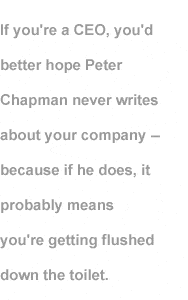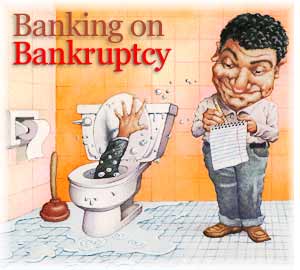 |
|
||||||||||||

|

|
|
By Kathy Spring
|
Peter Chapman is a special sort of obituary writer: he doesn't just write about deaths, he anticipates them. And every one of his subjects is a high-profile power player worth billions of dollars. Chapman publishes newsletters on corporate bankruptcies. Ignoring naysayers -- "You don't even have a law degree or an M.B.A.," his sister once warned -- he is the self-taught expert journalists turn to for commentary when blue chips go under. And more important to his bottom line, he is the totally informed insider from whom hundreds of attorneys, accountants, and creditors purchase newsletters. Chapman maps for his readers the convoluted, court-supervised road a bankrupt company must travel en route to either extinction, sale, or a return to financial health.
Chapman entered the field some 12 years ago as a way to amuse himself during downtime at a student job with a book publisher. "The work you really have to get done in a job takes about two hours," he says. "You have to [find something to do] with the other six." From time to time, announcements that a customer had gone bust crossed his desk. His employer, who thought it would be impossible to collect on the books they'd shipped to these customers, told him to just throw the bankruptcy papers away. But showing the independent streak that would eventually lead him down the independent professional path, Chapman ignored his boss. "I'm not someone who necessarily follows orders well," he admits. Using a copy of the Federal Bankruptcy Code, he figured out how to collect from these bankrupt customers. His boss, the last he ever had, was pleased. And Chapman, whose only thought was that he never wanted to be an employee again, had stumbled upon an idea for a business. After graduating from the University of Cincinnati, Chapman hung out in the Cincinnati courthouse copying creditors' names from publicly available bankruptcy documents. He sent them postcards offering to obtain filings and attend creditors' meetings for them. The bankruptcies were small, but he got enough clients to build a profitable business. Big Break from a Broke Biz A few years later, Chapman's regular trip to the courthouse brought big news. Federated-Allied Stores, the $11 billion parent corporation of retailing giants such as Bloomingdale's and Burdines, had filed for bankruptcy in his home base. Chapman's first reaction was: "How am I going to send postcards to 100,000 creditors?" He made "a make-or-break business decision" and took out a five-day advertisement in the Wall Street Journal offering to keep creditors informed of every aspect of this enormous bankruptcy action. Responses poured in, and he established a readership for his first bankruptcy newsletter. Today, Chapman has published newsletters on many of the largest corporate bankruptcies of the past two decades, including Macy's, Abraham & Straus, Dow Corning, Grand Union, and Zenith. He's even become a player himself by buying and selling the debt of bankrupt companies. His work has made him carefully attuned to the signs of financial slippage that will make his cash register ring. Now he doesn't just react to bankruptcies, he anticipates them. The Poultry Problem No matter where he is or what he's doing, Chapman is on the trail. "The highlight of my day is picking up the Financial Times and reading some obscure information that's an intricate piece of [the puzzle]," he says. "The hunt is fun." But he finds clues in unlikelier places, too. Such was the case with one of the bankruptcies he recently covered. "With Boston Chicken, the handwriting was on the wall six months ahead of time. The goose was getting cooked." "You go to Boston Chicken and everything is confused," he explains. "You get to the window and find they didn't get your order right. Thirty people are working behind the counter and the creamed spinach is cold." He stopped eating at the chain, but followed its advertising, in which he also detected signs of trouble. "Meat loaf! They added meat loaf," he exclaims in mock horror. "Six people in America every year go out and order meat loaf! "And it gets better," he laughs. "They then added ham! There are two people who go out for ham." Chapman thought subsequent marketing changes, such as the company's decision to rename the chain "Boston Market," were ill-advised. This prompted him to order Boston Chicken, Inc.'s quarterly and yearly financial statements. He found that unpopular menu choices and cold spinach were only the tip of the iceberg. "Do you know what [Boston Chicken, Inc.] really owns?" he asks. "In their annual reports all the talk is about chicken and mashed potatoes and bricks and mortars, but as a public company, they are little more than a big bank. They own a bunch of entities that lend money to people in the restaurant business." The accounting for these entities, while perfectly legal, had been done in such a way that losses at the restaurants were buried. "And the losses were huge," Chapman discovered. He had seen enough to get started on another newsletter. A couple of tiny items in the Wall Street Journal about missed loan payments, and his latest newsletter was "in the word processor, ready to go." Doing Away With Deadlines Chapman actually issues several newsletters about each bankruptcy. The first contains background material on the company and detailed information on what it owns and what it owes. It identifies the key players, including creditors and the judge who will preside over the case. This, and all the other information in his newsletters, is public information. Chapman, who hates deadlines, does not publish on a schedule, but rather reads every single piece of paper the bankruptcy generates, attends trials and hearings, and publishes a new issue when there is news his subscribers need to know. Each newsletter runs from ten to twenty pages and costs $45 an issue. "Expect to spend $1,500 before it's over," Chapman tells his clients. He works with about 12 bankruptcies at any given time. As one settles, usually after years of proceedings, another pops up. Each case he covers tends to be in a different stage, some with lots of activity to report on, and others with very little. In a typical billion-dollar bankruptcy (the only kind he finds worth tackling), Chapman seeks subscribers from a pool of parties who have some interest in the proceedings. Attorneys, suppliers owed money by the company, accountants, competitors, and prospective buyers make up the bulk of his subscription list. The work necessary to keep on top of developments in these cases is more than many professionals want to put in, and Chapman says he has never run into anyone else who publishes company-specific bankruptcy newsletters. So, for hundreds of parties in each bankruptcy, Chapman's newsletter becomes the most convenient way to keep informed.
Working Without Networking Since the interested parties change in every case he covers, every set of bankruptcy newsletters has a different subscriber list. Some of his subscribers are repeat customers. This is especially true in the retail industry, which is full of many big companies that have reorganized under bankruptcy. But the process of finding clients goes way beyond relying on repeat business. Chapman advertises his newsletters by sending email announcements to every party with a substantial interest (at least $250,000) in the action. He also uses a PR newswire to get his name out, speaks at conferences to build goodwill, sends "lots" of free copies to his target audience, and gives case updates to journalists in the cities where the bankruptcy trials are held. He carefully courts the people he wants as readers and discourages those he doesn't. Still, Chapman has found that nothing builds business relationships like personal contact. Since he hates networking and introducing himself, he's developed less painful methods for meeting people. "I'll go up to a lawyer in a courtroom and just say, 'I'm writing on this case, could you please tell me how to spell your name?'" He then shakes hands, gives the attorney his card, and promptly sends him a complimentary copy of the newsletter. "And the next day, there is my newsletter on his desk, and he begins to connect the name with the face." Chances are, that lawyer will become a regular subscriber.
Not surprisingly, Chapman, who spends all day studying corporations with money problems, is very conscious of keeping his own finances strong. Emailing his newsletters keeps costs down, and Chapman is always on the lookout for more ways to streamline his overhead. He constantly asks himself: "Am I maximizing the revenue and keeping costs in check? Can I raise prices? Is there a more clever way to send the newsletters out? Is there a population I have missed? Can I find cheaper sources? Do I really need Windows 2000?" And his careful analysis of business expenses also crosses over into his personal lifestyle. A little bit of frugality helps to ensure he never has to be an employee again.
Having created a one-of-a-kind business to support a comfortable debt-free life, Chapman finds his work absorbs him so completely that it doesn't feel like work. It's just a way of life. "I make a living. I do what I enjoy. I learn something new every day. I think that's what everyone should do," Chapman says. |
||||||||||||||||
|
January 31, 2000 Primary Editor: Katy Demcak Illustrator: Todd Bonita Production: Keith Gendel |
We'd love to hear your comments about this article! Kathy Spring is a freelance writer who lives in Trenton, NJ. If you like, we'd be happy to put you in touch with her, or with anyone named in this article. | ||||||||||||||||
|
| |||||||||||||||||